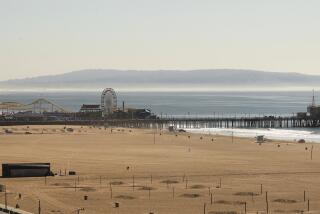For volleyball, the beach is where it’s at
- Share via
LONDON — The distance between the places they play beach volleyball and indoor volleyball in these London Olympics is less than three miles. They are also light-years apart.
They play beach volleyball at a place called Horse Guards Parade. The beach is a concoction while everything around it is historic, important, landmarks of wars and heroes of peace. It is a little like putting a tattoo on the Mona Lisa.
But it is temporary and no offense is being taken.
The crowds of summer tourists would be here anyway. Buckingham Palace and Westminster Abbey are a short walk. The statue of Churchill stands proudly as traffic swirls around it. Huge buildings of classic architecture border the trucked-in beach, giving the temporary bleachers and miles of fencing a backdrop of beauty and majesty. NBC must have drooled all over itself when it showed up to look; that’s presuming NBC didn’t have a hand in the site selection.
Tuesday, as thousands walked the area nearby, students gave street lectures on suffrage near the Monument to the Women of World War II. The sounds of a public address system at a beach bellowed forth, leaving the impression that somebody was holding a monster truck show.
But it is temporary and no offense is being taken.
The indoor volleyball is being played at Earls Court, a massive exhibition hall opened in 1937. It hosted several sports in the 1948 London Games and had been, for years, a place for gatherings of large groups as diverse as leaders of sports and leaders of Fascism.
Time has been unkind to Earls Court. Across the street is an unkempt graveyard. On the corner is a large pub named the Tournament. Its windows are boarded.
Alan Lee in the Times of London writes that Earls Court staged the Brit Awards for a decade, but “maybe they were all too drunk to notice its inherent dreariness.”
Huge Olympic banners greeting fans are faded and torn.
But the Olympic presence at Earls Court is temporary, and no offense is being taken.
At Earls Court, they have a crew of 10- to 12-year-olds in cute little outfits. They entertain the crowds with acrobatics. At the beach, they also have crews entertaining the crowds, but you can rest assured none are 10 to 12. The tight pants, the hair pinned up and the dark glasses — dark glasses in the one city in the world where you may never need them — attest to that.
Tuesday, U.S. women excelled in both places.
On the beach at Horse Guards Parade, Misty May-Treanor and Kerri Walsh Jennings won their way into the final against another U.S. team, Jennifer Kessy and April Ross. On the floor at Earl Court, U.S. women’s volleyball Coach Hugh McCutcheon’s Anaheim-trained team beat the Dominican Republic in straight sets and will face South Korea in one semifinal. Brazil and Japan also won their quarterfinals and they will meet in the other semifinal Thursday.
It is difficult to take in both versions of the sport and not have questions. Such as:
—Has the wide disparity between venue quality here created hard feelings among those in the indoor sport, especially because beach and indoor are run by the same federation?
—Which sport are you seeing more back in the States on NBC? (Never mind. We know the answer).
—Is there any growing recognition among viewers that the Olympics seem to be edging away from sports that are only sports, and toward sports that are both sport and spectacle?
May-Treanor and Walsh Jennings are incredible athletes who compete in sand and bikinis. Logan Tom, Lindsey Berg and Destinee Hooker are incredible athletes who compete indoors in spandex. The ball is the same. So is the net. Rules are virtually the same.
But clearly, despite the demanding teamwork, intricacies and complexity of the indoor game, the simpler, quicker beach game has won the popularity contest. Or is it the sand and bikinis?
McCutcheon has a nice view of this from which to speak. He coached the U.S. men to gold in Beijing and now is two games away from doing the same for the women. He is asked if his game is being overshadowed and devalued by the beach game.
“We are all part of the same foundation, all volleyball,” he said Tuesday night. “The more volleyball on TV, the better it is for all volleyball. If we grow the sport through bikinis, or through spandex, we are still growing the sport.”
We will take his answer as a definite maybe.
More to Read
Go beyond the scoreboard
Get the latest on L.A.'s teams in the daily Sports Report newsletter.
You may occasionally receive promotional content from the Los Angeles Times.







